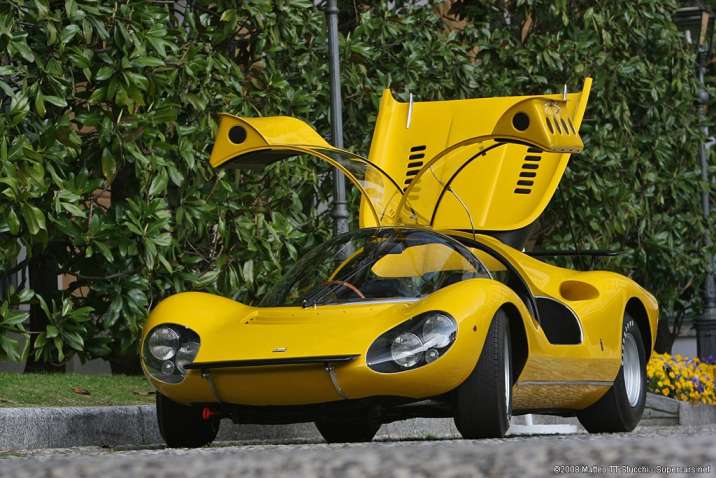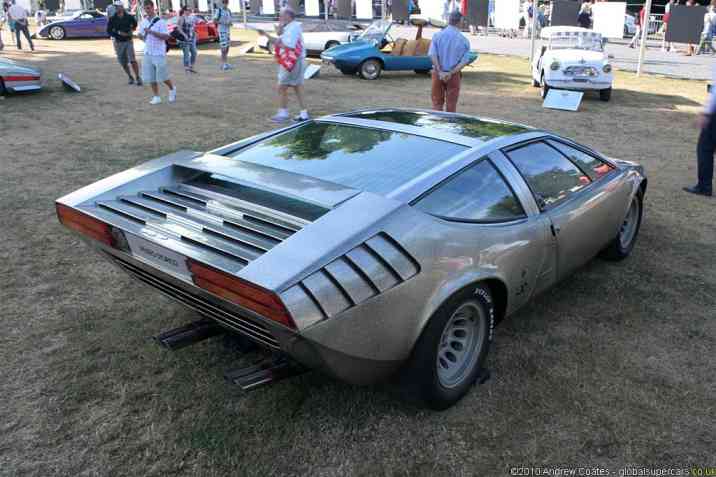Lamborghini 1967 Geneva Motor debut, the Marzal, was never meant to be a mass-market. According to Ferruccio Lamborghini, Marcello Gandini of Bertone created a clean concept, but some features would eventually be employed in the manufacture of Espada. But thanks to Dinky and Matchbox toys, it would live on forever in the minds of devotees in small form.
1967 Dino 206 Competizione Prototipo

This Paolo Martin-designed Ferrari sports car was one of his first for Pinin Farina and was inspired by the Dino-engine-powered Ferrari race cars that were run at Le Mans. The racing Dinos' appearance clearly reflects a family connection, but a large portion of the design was entirely original and intended to push the limits of aerodynamics.
1967 Fiat Dino Parigi
The 1967 Paris car show was the venue of the Fiat Dino's debut, hence the name of this shooting-brake variant. It was an experiment with the aerodynamics of Kamm-tail designs as much as it was an exercise in the potential of the shooting-brake approach. With the Parigi, one of three Pininfarina models built on the Fiat Dino chassis. Paolo Martin was able to refined his streamlined concepts
68 Alfa Romeo 33 Carabo
Even though the Alfa Romeo 33 Stradale was a stunning vehicle, the race team Auto delta found it to be prohibitively expensive to purchase and impossible to construct. The car was supposed to be a road car homologated for racing, but Alfa Romeo ultimately failed to sell five, so they gave the chassis to the best designers in Italy. The scissor doors of Marcello Gandini's Carabo, which have become a standard in supercar design ever since, make it perhaps the most significant concept automobile ever created.
1969 Alfa Romeo 33 Iguana

Giorgetto Giugiaro was a pioneer in wedge-shaped design alongside Gandini. Parts of this can be seen in his 33 Iguana idea, which was one of the initial works for his newly established Ital Design company. It was later fitted with an Alfa Romeo Montreal engine in place of the original 33 Stradale engine. Alfetta GTV and Maserati Bora features can be found elsewhere in the design, while Giugiaro's De Lorean DMC-12 would later be influenced by its brushed-metal roof frame and cabin pillars.
Read more:- 20th Centurys Biggest Engines for Big Brand
1970 Lancia Stratos Zero
This Lancia, another masterwork by Marcello Gandini, was appropriately science fiction and took its name from the stratosphere. It is based on a smashed Lancia Fulvia HF1600 rally vehicle and highlights a retractable controlling wheel, a dashboard gotten to by climbing up the front of the car, and a then-novel advanced control panel. Its maximum height is 84 cm (33 in). A few aspects from this concept would be carried over into the later Stratos road/rally car, but it also helped define the wedge form as the cutting edge of automotive design.
2000 Maserati Buran
Mercedes-Benz's R63 AMG is famous for inserting a powerful 6.2-liter V8 engine in a MPV; The results are sharp and, according to reports, something is frightening. However, the hypercar SUV could have come earlier, and we were not talking about the renalt aspace with an F1 engine, which the production reality was nowhere - on the contrary. Masherati Buran concept designed by Gorgetto Giugiaro with four-wheel-drain system mixed with 3200 to 3.2-liter twin-turbo V8, and sliding doors for easy access
1999 De Tomaso Nuova Pantera 2000
De Tomaso went through more in Doldrums with Guara and Bigua in the 1990s, but with the 1999 Panera concept, the amazing Ancient title was brought back to life. Designed by Marcello Gandini, it was only a static concept car, and it would be the last manufactured by the Day Tomaso Company; It turned in 2004. There is no interior, window or running gear - just a prototype was officially terminated.
1974 Maserati Medici
It was going to be difficult to replace the original Maserati Quattroporte; in fact, Alejandro de Tomaso only produced a few road vehicles and multiple concept cars before abandoning the II and switching to the III. Giorgetto Giugiaro contributed two concepts to the Medici concept car project, which was one of the phases along the road. The center row of the six-seat Medici I, which is pictured above, was not facing the direction of travel. This Maserati Indianapolis-based vehicle debuted at the Turin Motor Show in 1974. It was reopened two years later with merely four seats, a bar, a refrigerator, a desk, file holders and a TV and radio.

.webp)





.webp)


.webp)

